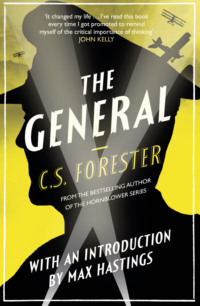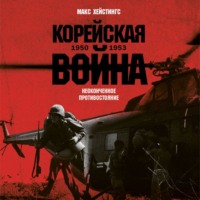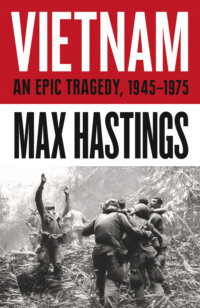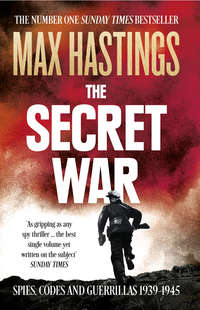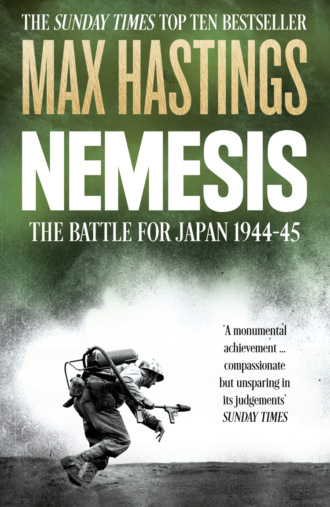
Полная версия
Nemesis: The Battle for Japan, 1944–45
Many British and American teenagers, without previous knowledge of life outside their own communities, found uniformed service a unifying and educating force. They learned that the only redemptive feature of war is the brotherhood which it forges. ‘The people are what I really remember,’ said USAAF pilot Jack Lee DeTour, who bombed South-East Asia from India. If men got home on leave, many felt alienated from civilians who had not shared their perils and sacrifices. ‘Only shipmates were important to me,’ wrote US naval rating Emory Jernigan. Eugene Hardy, a bosun’s mate, came from a farm family so dirt-poor that he had never set foot in a restaurant until he joined the navy in 1940. Men learned to live with others from utterly different backgrounds, often possessing quite different outlooks. For instance, a million messroom or foxhole arguments between American northerners and southerners featured the line: ‘You want a nigger to marry your sister?’ Somehow, out of it all, most men learned a lot about viewpoints other than their own, and about mutual tolerance.
A British soldier expressed in his journal reflections about wartime conscript experience which have almost universal validity: ‘Men live conscious all the time that their hearts, roots, origins lie elsewhere in some other life…They measure the hardships, privations, weariness here against the memory of a past that they hope to continue in the future…Since their hearts reside elsewhere, they face the present with an armoured countenance.’ The author meant that most warriors seek to preserve their sanity by shielding some corner of themselves from proximate reality, so often unpleasant. US naval officers protested at the assertively unseamanlike outlook of cryptanalysts working at the Pacific Fleet’s superb ‘Magic’ code-breaking centre in Honolulu, which played such a critical part in Allied victory. Their commander dismissed their complaints: ‘Relax, we have always won our wars with a bunch of damned civilians in uniform anxious to get back to their own affairs, and we will win this one the same way.’
Winston Churchill often asserted his conviction that the proper conduct of war demanded that ‘the enemy should be made to bleed and burn every day’. The Pacific and Burma campaigns, by contrast, were characterised by periods of intense fighting interspersed with long intervals of inaction and preparation. Whereas on the Russian front opposing forces were in permanent contact, and likewise in north-west Europe from June 1944, in the east Japanese and Allied troops were often separated by hundreds, even thousands, of miles of sea or jungle. Few Westerners who served in the war against Japan enjoyed the experience. It was widely agreed by veterans that the North African desert was the most congenial, or rather least terrible, theatre. Thereafter in ascending intensity of grief came north-west Europe, Italy, and finally the Far East. Few soldiers, sailors or airmen felt entirely healthy during Asian or Pacific service. The stifling heat below decks in a warship made daily routine enervating, even before the enemy took a hand. The only interruptions to months at sea were provided by brief spasms in an overcrowded rest camp on some featureless atoll. For those fighting the land campaigns, disease and privation were constants, vying as threats to a man’s welfare with a boundlessly ingenious and merciless enemy. ‘All the officers at home want to go to other theatres because there is more publicity there,’ wrote one of MacArthur’s corps commanders, Lt-Gen. Robert Eichelberger, in a gloomy letter to his wife.
Eichelberger was a career soldier, one of those whom war provided with dramatic scope for fulfilment and advancement. Civilians in uniform, however, were vulnerable to the misery identified by British novelist Anthony Powell, ‘that terrible, recurrent army dejection, the sensation that no one cares a halfpenny whether you live or die’. ‘Hello, suckers,’ ‘Tokyo Rose’ taunted millions of Allied servicemen from Radio Japan. ‘I got mine last night, your wives and sweethearts probably got theirs—did you get yours?’ Corporal Ray Haskel of the US Army wrote from the South Pacific to a Hollywood starlet named Myrtle Ristenhart, whose picture he had glimpsed in Life magazine. Rodgers and Hammerstein would have appreciated his sentiments: ‘My dear Myrtle, guess you are wondering who this strange person could be writing to you. We are here in the Pacific and got kind of lonesome and so thought we would drop you a few lines…There isn’t any girls here at all but a few natives and a few nurses and we can’t get within ten miles of them…When you can find time please answer this letter and if you have a small picture we would appreciate it, Sincerely your RAY. PS I am an Indian, fullblooded and very handsome.’
‘Here it is a Burma moon with not a girl in sight and a few dead Japs trying to stink you out,’ Sgt Harry Hunt of the British Fourteenth Army wrote miserably to a relative in England. ‘…It must be lovely to soldier back home, just to get away from this heat and sweat, from these natives, to get together with white men…There it comes, the rain again, rain rain that’s all we get, then the damp, it slowly eats into your bones, you wake up like nothing on earth, you always feel sleepy. I don’t know whether I’m coming or going, better close now before I use bad words, remember me to dad, mum and all.’
One of Hunt’s senior officers, Maj.-Gen. Douglas Gracey, took as bleak a view from a loftier perspective: ‘Nearly every Jap fights to the last or runs away to fight another day. Until morale cracks, it must be accepted that the capture of a Japanese position is not ended until the last Jap in it (generally several feet underground) is killed. Even in the most desperate circumstances, 99 per cent of the Japs prefer death or suicide to capture. The fight is more total than in Europe. The Jap can be compared to the most fanatical Nazi Youth, and must be dealt with accordingly.’
‘Dear Mother and Dad,’ Lt Richard Kennard wrote from one of the Pacific island battles in which he was serving as an artillery forward observer with the US 1st Marine Division. ‘War is just terrible, just awful, awful, awful. You have no idea how it hurts to see American boys all shot up, wounded, suffering from pain and exhaustion and those that fall down never to move again. After this war is all over I shall cherish and respect more than anything else all that is sweet, tender and gentle. Our platoon leaders and company commanders are more afraid of what their men will think of them if they don’t face the enemy fire and danger along with them than of getting shot by the Jap. I have my fingers crossed every minute I am up there in the front lines and pray each night that I won’t get hit.’
China’s people paid a vastly more terrible price than any other belligerent nation, at least fifteen million dead, for its part in the struggle against the Japanese. The country had been at war since 1937. Few Chinese dared to anticipate any end to their miseries, least of all victory. ‘In 1944,’ said Captain Luo Dingwen of Chiang Kai-Shek’s Nationalist army, ‘there seemed absolutely no reason to suppose that the war might end in 1945. We had no idea how long we might have to keep fighting.’ One of Luo’s comrades, Captain Ying Yunping, described a characteristic 1944 battle which, after two hours’ fighting, swung dramatically against the Chinese:
We got the order to retreat. A mass of men, horses, carts, was streaming back. It was a shambles. I suddenly saw Huang Qixiang, our general, hurrying past us on a horse, wearing pyjamas and only one boot. It seemed so shockingly undignified. If generals were running away, why should ordinary soldiers stay and fight? The Japanese were sending in tanks, and we had nothing to fight tanks with. But I felt we couldn’t just let the Japanese walk all over us. I called to my 8th Section, whose commander was the bravest man in the regiment, and told him to take up a blocking position. He held out for hours—the Japanese were completely thrown by meeting resistance just when everything was going their way. We lost the battle—but it seemed something to win even one small part of it. I met our general a little while later. I said that it was quite safe for him to ride back and fetch his uniform.
A vast host of Chinese civilians served merely as victims. Chen Jinyu was a sixteen-year-old peasant girl, planting rice for the Japanese occupiers of Jiamao, her village. One day, she was informed by the Japanese that she was being transferred to a ‘battlefront rear-service group’. She said: ‘Because I was young, I had no idea what this meant, but I thought any duty must be easier than working in the field.’ A week later, she discovered the nature of her new role when she was gang-raped by Japanese soldiers. She ran away home, but an interpreter arrived to say that her family would suffer grievously if she did not return to her duties. She remained a ‘comfort woman’ for the local Japanese garrison until June 1945 when, weary of beatings, she fled to the mountains and hid there until she heard that the war was over.
Tan Yadong, a nineteen-year-old Chinese who served the Japanese in the same capacity, was accused by a Japanese officer of failing to be an ‘obedient person’. After two five-day spells of solitary confinement, ‘I became an obedient person.’ She was vividly reminded of the consequences of displeasing the Japanese when one of her comrades failed to take contraceptive medicine, and became pregnant. ‘They didn’t want this baby to be born so they hung this poor girl from a tree. They killed her by cutting her open with a knife in front of all the people of our village. I was quite close, only six or seven metres away. I could see the baby moving.’
At least a million Vietnamese died in their country’s great famine of 1944-45, which was directly attributable to Japanese insistence that rice paddies should be replanted with fibre crops for the occupiers’ use. Much Vietnamese grain was shipped to Japan, and rice commandeered to make fuel alcohol. The people of the Philippines and Dutch East Indies also suffered appallingly. In all, some five million South-East Asians died as a result of Japanese invasion and occupation, including 75,000 slave labourers on the Burma Railway. If the British could take little pride in their wartime stewardship of the Indian subcontinent, where white guests of Calcutta’s clubs could order unlimited eggs and bacon while Bengalis starved in the streets, never did they match the systemic barbarism of Japanese hegemony.
US forces fought their way across the Pacific supported by an awesome array of wealth and technology. American observers on the Asian mainland were appalled by the contrasting destitution which they everywhere perceived, and impressed by the political forces stirring. ‘There are over a billion people who are tired of the world as it is; they live literally in such terrible bondage that they have nothing to lose but their chains,’ wrote Theodore White and Annalee Jacoby in 1944. They noted the twenty-seven-year life expectancy in India, jewel in Britain’s imperial crown; a China where half the population died before attaining thirty. They described the lifeless bodies of child workers collected each morning outside factory gates in Shanghai; the beatings, whippings, torture, disease and starvation that were commonplace across the continent.
During China’s famines, vastly worsened by the Japanese war, people hunted ants, devoured tree roots, ate mud. The North China Herald deplored the prevalence of kidnapping and extortion: ‘In some districts, it has been customary to roast the victims in big kettles, without water, until the flesh falls from the bone.’ White and Jacoby wrote: ‘Everywhere in Asia life is infused with a few terrible certainties—hunger, indignity, and violence.’ This was the world Americans perceived themselves advancing to save, not merely from the Japanese, but from imperialists of every hue—including their closest allies, the British. Churchill nursed the ill-founded delusion that victory over Japan would enable Britain to sustain its rule in India, and reassert command of Burma and Malaya. The US cherished a parallel fantasy, equally massive and misguided, about what it could make of China. Frank Capra’s China film in the famous US War Department Why We Fight documentary series portrayed the country as a liberal society, and made no mention of Communists.
The Japanese, meanwhile, cherished their own illusions. As late as the summer of 1944, much of their empire still seemed secure, at least in the eyes of humbler members of its ruling race. Midshipman Toshiharu Konada loved his ‘runs ashore’ on Java from the heavy cruiser Ashigara. ‘Everything was so new and exotic to us young men,’ he said. Once a chorus of local children serenaded a leave party from the fleet with Japanese songs. Konada and a cluster of other men from his ship dined at a local Italian restaurant, ogling the proprietor’s daughter, one of the first European girls they had ever seen. ‘I thought: I am seeing the bright future of Asia here. The whole area seemed so peaceful. Many of the Chinese in Singapore were friendly to us.’
Twenty-year-old Konada was the son of a naval officer commanding a Pacific base. He himself had wanted to be a doctor, but relinquished that ambition when he was drafted in 1943. ‘I knew Japan must be defended, and I wanted to “do my bit”.’ The following year, when Ashigara and its consorts were redeployed to northern Japan to guard against an American threat from the Aleutians, ‘we started to feel a mounting sense of peril’. In the gunroom with his fellow midshipmen, ‘we never talked about what might happen after the war, because it seemed so remote’. He knew nothing of his father’s fate, because there was no mail from the Pacific islands. The midshipmen simply concentrated on their immediate tasks—studying hard for promotion exams and maintaining journals which were rigorously examined by their divisional officers.
Diversions were few in the long wait for a fleet action: every night, Konada or some other junior officer commanded a picket boat which patrolled the waters round the ship. Their biggest excitements were spotting the head of an apparent frogman in the darkness, which proved to be a giant turtle, and detecting torpedo tracks which translated into a shoal of tuna. They recognised the power of the American and British navies. However, when they gazed around their anchorages at the serried ranks of battleships, cruisers, destroyers which Japan still possessed, there seemed no grounds for despair. ‘We understood that this would be a long, hard war. But it seemed worth it, to achieve peace and security for Asia.’
Lt Cmdr Haruki Iki had been flying in combat since 1938, when he bombed retreating Chinese on the banks of the Yangtse. Iki, now thirty-two, was a famous man in the Japanese navy, the pilot who sank Repulse off Malaya. By the summer of 1944 he commanded a squadron flying long-range reconnaissance from Truk. They were bombed almost daily by high-altitude US Liberators. Most of the bombs fell into the sea, but raids caused the Japanese airmen to spend many hours in the caves which served as shelters. In the air, the planes under Iki’s command suffered relentless attrition. Replacement crews arrived scarcely trained. He found himself teaching signals procedures to radio operators who knew the principles of Morse code, but had never touched a transmitter. By high summer, the strength of his force had fallen from thirty-six aircraft to twelve. He was recalled to Japan to command a unit of Ginga bombers.
Masashiko Ando, twenty-three, was the son of a Japanese governor of Korea. None of this grandee’s three boys had wanted to pursue military careers, but all were obliged to do so. The eldest died fighting on Saipan, the second perished as an army doctor in New Guinea. By July 1944 this left Masashiko the only survivor, just graduating from the Navy Academy’s flight school. He had chosen to serve at sea, because an admired uncle was a naval officer. He was lucky enough to be in one of the last classes of cadets to receive thorough training, before fuel and aircraft became scarce. When postings were apportioned, he was the only cadet to apply for seaplane duty. Within a month, he was flying anti-submarine patrols in a single-engined, three-seater Judy dive-bomber.
He and his crew’s routine missions lasted two or three hours, covering convoys pursuing their sluggish courses towards Japan from Malaya or the Dutch Indies. Their aircraft were primitive by Allied standards. Lacking radar, they carried only a magnetic ship-detection device, together with a single 120-pound depth-charge, for the unlikely eventuality that they found an American submarine. Conducting box searches twice a day, month after month, might seem a dreary task, but it was not so to Ando, who loved to fly. His conscientious crewmen, Kato and Kikuchi, were younger than himself in years, but not in naval experience. They scanned the sea intently, searching for a telltale periscope wake.
After a while, they drank coffee from thermoses and ate their flight rations. These had improved somewhat since a disgusted pilot complained to their messing officer: ‘Every day might be our last! Is this muck the best you can do for our final meals?’ If they needed to urinate while they were in the air, a complex procedure was invoked. Each crew carried a folded oiled paper container which, once filled and sealed with a knot, was handed over the pilot’s shoulder to the magnetic search operator in the rear seat, to be thrown out of a window. Carelessness would cause the container to burst open in their faces. Even in the last year of the war, at Japanese bases in Indochina and the Dutch islands, there was enough to eat and plenty of fuel. Only aircrew replacements were in short supply. ‘We realised that Japan was in a tough spot,’ Ando said, ‘but not that we were in danger of losing the war. We young men believed that, whatever was happening, we could turn the tide.’
Staff officer Maj. Shigeru Funaki felt almost embarrassed that his life at China Army headquarters in Nanjing was so safe and comfortable—good food and no enemy bombing. ‘In Japan, one felt very conscious of what a mess we were in. But in China, our lives seemed so normal that we lulled ourselves into thinking that somehow, our country would come through OK. I was always proud of the fact that, whatever happened in other theatres, in China we remained victorious. For that reason, it seemed a good place to serve.’
Many young Japanese, however, discovered by experience the growing vulnerability of their nation’s empire. In October 1944 Lt Masaichi Kikuchi was posted to the Celebes, south of the Philippines. Having taken off by air from Japan, he and his draft were forced to land on Formosa by engine failure. They remained marooned there for the next two months, among several hundred others in similar plight, enduring a rain of American bombs. When they finally escaped, it was not to the Celebes, now cut off by the Americans, but to Saigon. A sea voyage which normally took a day lasted a week, as their convoy of empty oil tankers lay close inshore by day, then progressed southwards in a series of nocturnal dashes. The military passengers were kept on almost permanent anti-submarine watch, and the convoy was bombed four times.
Huddled wounded in a cave on a Pacific island, Sgt Hiroshi Funasaka looked down on an American camp, brightly lit in the darkness: ‘I imagined the Americans sound asleep in their tents. They might well be easing their weariness by losing themselves in a novel. In the morning they would rise at leisure, shave, eat a hearty breakfast, then come after us as usual. That sea of glowing electric lights was a powerful mute testimonial to their “assault by abundance”…I had a vision of the island divided into adjoining heaven and hell, only a few hundred metres apart.’
None yearned more desperately for Allied victory than prisoners-of-war in Japanese hands, of whom many thousands had already died. Those who survived were stricken by disease, malnutrition and the experience of slave labour. British soldier Fred Thompson wrote on Java: ‘We have just started a new ten-hour shift. How long the chaps will be able to cope remains to be seen. All of us have given up guessing when we will be out—we have had so many disappointments. We are all louse-ridden, but it is one diversion anyway—big-game hunting. Keep smiling through.’
In the summer of 1944, only a few hundred thousand Japanese confronting the Allies in New Guinea, the Pacific islands or Burma, at sea or in the air, had seen for themselves the overwhelming firepower now deployed against their country. Every Japanese was conscious of the privations imposed by American blockade, but the home islands had suffered only desultory bombing. The prospect of abject defeat, which air attack and massive casualties on the Eastern Front obliged Germans to confront long before the end, was still remote from Japan. By late 1944 Hitler’s people had suffered over half their total wartime losses, more than three million dead.
By contrast, a year before capitulation Hirohito’s nation had suffered only a small fraction of its eventual combat and civilian casualties. Japan’s human catastrophes were crowded into the last months of war, when its fate was sealed, during the futile struggle to avert the inevitable. Japan’s commanders and political leaders were privy to the desperate nature of their nation’s predicament, but most remained implacably unwilling to acknowledge its logic. In the last phase, around two million Japanese people paid the price for their rulers’ blindness, a sacrifice which availed their country nothing. After years in which Japan’s armies had roamed Asia at will, killing on a Homeric scale, retribution was at hand.
2 SUMMIT ON OAHU
Japan’s advance across the Pacific and South-East Asia attained its zenith in the spring of 1942, when Australia seemed threatened with invasion, and the British Army was forced back through Burma into India. Long ground campaigns proved necessary to recover from the Japanese Guadalcanal, Papua-New Guinea and other Pacific bases which they had seized. Desultory British attempts to return to Burma were frustrated. The US build-up was slow, in conformity with Washington’s commitment to ‘Germany First’—priority for the western war. America’s Pacific Fleet wrested mastery of the seas from the Japanese only after a long succession of clashes, great and small, which cost many ships, planes and lives. The Allied counter-offensive was hampered by the contest for mastery between the US Army and Navy. The two services conducted separate and rival campaigns against the Japanese, spuriously dignified as ‘the twin-track strategy’.
Despite all these difficulties, by the summer of 1944 the material strength of the US was becoming overwhelming, the Japanese comet was plunging steeply. The trauma inflicted on the Americans and their allies by Pearl Harbor, the loss of Hong Kong, Malaya, Singapore, Burma, the Dutch East Indies, and scores of Pacific islands, had faded. The challenge confronting the leaders of the Grand Alliance was no longer that of frustrating Japan’s advance, but instead that of encompassing its destruction. Strategic choice had become the privilege of the Allies. In the eastern war, this meant that the political, military and naval leadership of the US determined courses, then informed the British.
Early in the afternoon of 26 July 1944, the cruiser Baltimore passed Hawaii’s Diamond Head inbound for Pearl Harbor. Insecure gossip had prompted a crowd of soldiers and sailors to gather at the navy yard. Off Fort Kamehaha, as the big warship lost way a tug nosed alongside, carrying Admiral Chester Nimitz, commander-in-chief of the Pacific Fleet. Then Baltimore moored at Pier 22B, enabling more flag officers and generals to ascend the gangway and form up to salute the cruiser’s exalted passenger, the President of the United States. Franklin Roosevelt, in the last nine months of his life and in the midst of his fourth presidential election campaign, looked about for Douglas MacArthur, the man he had come to meet. He was told that the general’s plane had just landed. MacArthur was on his way from Fort Shafter, and would arrive shortly. Sure enough, cheers and whistles along the Honolulu road heralded America’s most famous soldier since Ulysses S. Grant. MacArthur’s car swept up to the dockside. The great man emerged in khaki trousers, a brown leather air force jacket, Chief of the Army’s cap and insignia. As bosuns’ pipes screeched, he mounted the gangway, saluted the quarterdeck and went below to meet Roosevelt.


